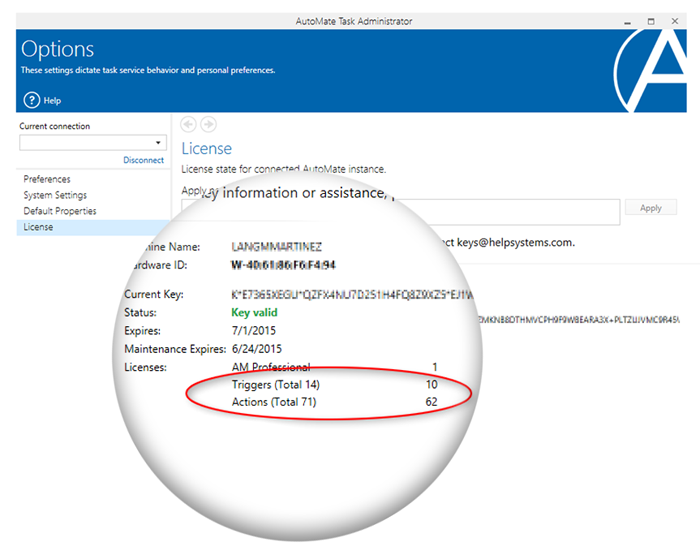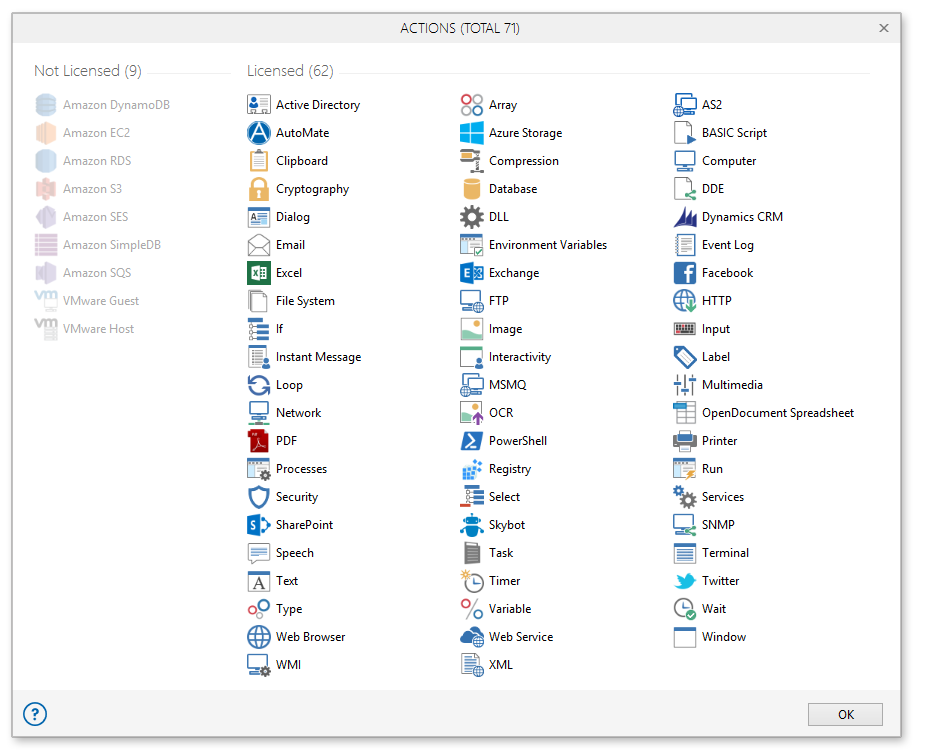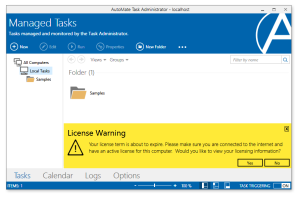Automate Licensing & Maintenance
|
Overview
Automate is designed to offer specific software editions and feature
sets to enable scalability for small businesses to large enterprises.
The available licensing models allows you to start small and upscale your
platform requirements to support business growth as necessary, all without
any down-time periods or difficult changes. Automate editions offer an
extremely cost effective means of automating a single desktop or multiple
machines.
You can acquire a basic, stand-alone license primarily designed for
individual desktop automation or one that allows remote deployment and
execution of tasks and processes. In addition, the newly developed feature-based
licensing model enables you to acquire actions and triggers individually.
All purchased editions and feature sets are tied to a single license key.
Adding new features or upgrading to a new edition is as simple as entering
a new license key. See License for additional
details.
There are several types of Automate
software editions offered to
best fit a company's needs. Each computer used for management,
development or execution of automated tasks and business processes
using Automate 10 requires a license. If you wish to connect to other
Automate clients on your network, you must acquire an Automate Premium
license for the local computer and a license for each separate computer
on which the Automate client is installed.
The type of licensing system employed
by Automate editions is similar to a Fixed Term License (FTL) which
offers customers the flexibility to use the software for a predefined
period, which is ideal for users with varying usage requirements over
time. Subscriptions begin on the date that your order is processed
and renew automatically on the calendar day following the expiration
of a prior subscription or on the calendar day following the anniversary
date. Each license is enabled by a license key that is specific to
the computer on which an Automate instance is installed.
Available Automate Editions
The following table provides a brief description of each licensed
edition included in the Automate product line.
|
Edition
|
Description
|
|
Automate
Professional
|
Automate
Professional is a basic, stand-alone version primarily designed
for individual desktop automation. This version contains all
of the user interfaces and triggers found in the Premium edition
but lacks the ability to connect to remote Automate clients
(or Runtime components). It is also lacking a handful of actions
that are mainly used for automating cloud based or enterprise
resources. Each Automate Pro license enables development,
management and execution of tasks only on the local computer; it will not be able to
connect to any remote Automate client.
|
|
Automate
Desktop
|
Automate
Desktop contains all of the functionality found in the Professional
edition along with an array of additional actions designed
to offer greater flexibility and implementation options to
the businesses that require them. Each license enables development,
management and execution of tasks on the local computer and
deployment of tasks onto remote "Runtime" components
installed and licensed remotely. Automate Premium Editions
enable tasks to be deployed to remote runtime installations.
This offers an extremely cost effective means of automating
multiple machines. With the Premium Edition, tasks can be
constructed, organized and deployed from one convenient location
instead of being spread throughout the organization. The Premium
edition edition supports the following remote access connection
types:
-
Local Premium to
Remote Premium
-
Local Premium to
Remote Runtime
-
Local Premium to
Remote Professional
A single Premium license supports up to 10
concurrent connections.
That number includes all connections, including local host.
|
|
Automate
Runtime
|
An Automate Runtime
component does not contain any user interface. It runs as
a service on the remote computer and enables the execution
of tasks built and deployed by the Premium edition. Runtime
licenses for the Premium Edition are sold separately.
|
|
NOTE: The purchase of Automate
Professional or Premium includes 1 license for task development
and execution. Runtime licenses for the Premium Edition are
sold separately.
|
The fastest and least painful solution to reduce software costs
is to eliminate unnecessary, under-utilized or unused features. Automate
10 supports feature-based licensing, which benefits those that require
use of only specific actions or triggers by allowing such items to
be licensed separately. This type of licensing can reduce initial
purchasing expenses and provide monetary savings for a company. As
the company grows, additional actions and/or triggers can be licensed
to fit increased development and operations. Adding new capabilities
only requires a new license key to turn on new actions or triggers,
once they are purchased.
Task Administrator's
License page provides information
about currently licensed and unlicensed actions and triggers (shown
below). They indicate the total number of actions or triggers available
for purchase and ones that are already purchased, included in the
current license, and active for use.

Viewing Licensed vs. Unlicensed Actions
To view a full list of individually licensed vs. unlicensed actions,
simply click Actions (circled
above). This opens a window that separates currently unlicensed and
licensed actions (shown below).
Each action is listed in their respective appropriate icon, however,
the unlicensed actions will be grayed out. To view more details about
a specific action, simply hover your mouse cursor over it. Click the
? button to open the help topic that reveals a complete list of available
actions.

Viewing Licensed vs. Unlicensed Triggers
To view a full list of individually licensed vs. unlicensed triggers,
simply click the Triggers link.
This opens a window that separates currently unlicensed and licensed
triggers (shown below).
Each trigger is listed in their respective appropriate icon, however,
the unlicensed triggers will be grayed out. To view more details about
a specific trigger, simply hover your mouse cursor over it. Click
the ? button to open the help topic that reveals a complete list of
available triggers.

An Automate 11 evaluation
license is separate from that of a permanent or production license.
Below describes each type and how they are implemented.
Evaluation License
Evaluation
licenses are granted to those who wish to evaluate a fully
functional copy of Automate before making a purchase. An evaluation
license is a free, non-commercial, short-term license designed to
enable usage and examination of the software to determine whether
it is a good fit for you and your organization's needs. The
evaluation period
begins upon initial software installation and lasts for a period of
30 days.
Production License
A
production (or permanent) license is separate from that of an evaluation
license. A production license is a standard "paid" license
acquired upon purchase of Automate. Once obtained, the production license can be pasted over
the evaluation license and will be used for software validations for
the duration of the term. If multiple licenses are purchased,
each one will appear in the License
page of Task Administrator.
License validation is a procedure that verifies that the software
license is valid, used in accordance with the End User License Agreement
(EULA) and guarantees that customers receive genuine copies of products
that they purchase. It is also implemented to reduce piracy by ensuring
that the software is not being used on any device other than the one
for which it was purchased.
Whenever Automate
starts,
it reads the available license key along with the local computer's
hardware ID to determine its validity. The hardware ID is a short
character string or "fingerprint" of the computer's hard
disk ID, Ethernet MAC address and other unique hardware elements.
It is tied directly with the license key entered and used to identify
the hardware platform on which Automate is installed. You can also
generate a hardware ID from
within the Hardware ID Provider application
which can be executed on computers where you intend to install Automate.
A change to
the network interface (physical, virtual, or wireless) may generate
a hardware ID mismatch error, at which point, a new license key is
required. For more details about obtaining a new license, see Obtaining
Permanent License Key.
Automate also
keeps track of the license expiration date. If a license is
about to reach the end of its term, Automate alerts the user ahead
of time by way of a UI warning. This warning appears each time the Automate
service starts until the end of the term.
Product maintenance (also known as Software Assurance) is a contractual
agreement ensuring that the user will receive all major and minor
updates with regards to a licensed Automate product a full 1 year
term from the date of purchase. It also guarantees unlimited email
support and 3 incidents of telephone support for 1 point of contact
for the duration of the term.
A maintenance plan is required for all licensed Automate products
along with the original license. Having products with maintenance
expiring on different dates creates a confusing licensing scenario,
therefore, it is recommended that the maintenance plan is purchased
at the same time as the license. Maintenance is renewable at the conclusion
of the term of the contract.
When a product version
is installed which was released after the maintenance period has expired,
the user will be unable to access any functionality within the product,
therefore, it is important to renew maintenance at the end
of each term.
 Automate
Editions
Automate
Editions
 Feature-Based
Licensing
Feature-Based
Licensing
 Evaluation
vs. Production License
Evaluation
vs. Production License
 License
Validation
License
Validation
 Product
Maintenance
Product
Maintenance



